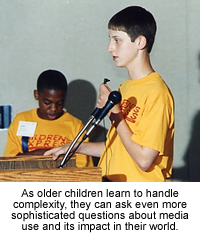Adapting the Five Key Questions to Different Ages
As children grow, their ability to question broadens and deepens.
By Elizabeth Thoman and Jeff Share
To adapt media literacy to various age groups, it is helpful to know how children and young people of different ages process the world, and how each state of development influences how they process and learn about the media world in which they are growing up. Developmental psychologists generally break childhood into five different developmental stages, although, of course, children grow and develop at their own unique pace, regardless of what the "experts" project.
Age 0-2 : The Senses Awaken
Symbolic thought begins during the first two years of life and parents need to provide a safe and stimulating environment for healthy development. Infant children need lots of experiential activities to interact with their physical environment through touching, smelling, tasting, listening and observing. While occasional media experiences (simple video stories or listening to recorded music) do not do harm to an infant child, extensive or even daily media exposure is not recommended.
Children under two gain more, developmentally, by interacting with a caring human being - by being sung to, talked to or danced with. The most important thing that parents can do at this age is to model healthy media use themselves thus establishing media routines in the home that will serve their children well as they get older.
Age 2-5: Language Builds Curiosity
Once children's language and problem solving skills start developing they are fertile ground for planting the seeds of critical inquiry. Plus their growing curiosity about the physical world makes them receptive to learning how everything works - and why!
Although some might question the appropriateness of introducing media literacy to preschoolers, this is precisely the age in which it ought to begin. Just like we recognize that learning the alphabet at age four is an important building block to being able to read a novel at 16, media literacy has building blocks that provide a foundation on which more complex skills are built.
It is important, for example, to encourage the habit of asking questions about media, to learn media vocabulary and to practice talking about what they see and hear and how it makes them feel. Children's videos (or TV series) by quality producers that incorporate developmental skills can be rich sources for segments that can be used to help children grasp the essence of each Key Question.
Age 6-8: Learning to Read
The one major developmental task of these years is to learn to read and preparation for reading requires several skills that can be enhanced by media literacy education. Understanding cause and effect, narrative storytelling and sequencing (beginning / middle / end) can be easily grasped (especially by reluctant readers) by analyzing mediated stories, especially favorite movies and TV series that kids love.
Children also need a rich vocabulary to be ready to read and the kinds of media they are exposed to can either enhance or impede vocabulary development. Some researchers indicate that a rich well-designed educational program can add thousands more words to a child's vocabulary than a formulaic Saturday morning cartoon.
In addition, the more young children can be exposed to different interpretations of reality, the more open they will become to accepting different ways of thinking, exploring different solutions and valuing cultural differences. Excellent tools can be picture books, videos or audio programs that tell similar stories from different perspectives thereby creating opportunities to ask questions such as #3: "What do I think and feel about this?" or #4: "Is anyone left out?"
Despite the common accusation that kids of this age shouldn't use media at all, media educators would suggest that just as kids need to be read to everyday and exposed to print-rich environments in order to become print literate, they also benefit from exposure to and exploration of media in order to become media literate. Whether print or electronic media, you can't make someone literate by keeping them away from it.
Age 9 - 11: Think Logically but not Abstractly
By elementary school, most children can think logically but are just beginning to be able to think abstractly or hypothetically. It is important for students to manipulate concrete objects and media production activities can address this need well. Children at this stage are less egocentric and activities like role-playing and taking pictures can be good ways to experience other people's point of view.
Children can also classify objects according to attributes, create surveys and process the information visually in Venn Diagrams and graphs. Some children at this stage could benefit from the Questions to Guide Young Children while others are ready for the Five Key Questions. The choice of questions can also depend on the student's vocabulary development since even older students learning English as a second language might benefit more from a simpler vocabulary.
Age 12+: Learning to Handle Complexity
As young people begin to be able to think abstractly, solve problems of probability, and generalize, media literacy offers great depth for both analysis and production. The Five Key Questions as well as the Expanded Questions can stimulate sophisticated inquiry. One's level of awareness should be to uncover both explicit and implicit messages in the content of a message as well as the medium that carries it. Analysis can move beyond quantitative research to examine the qualitative influences of a particular medium on a specific audience. Production can involve multi-step projects using powerful multi-media tools that demand not just envisioning but planning, organizing, executing and learning from others' feedback.
Most of the activities in the MediaLit Kit


